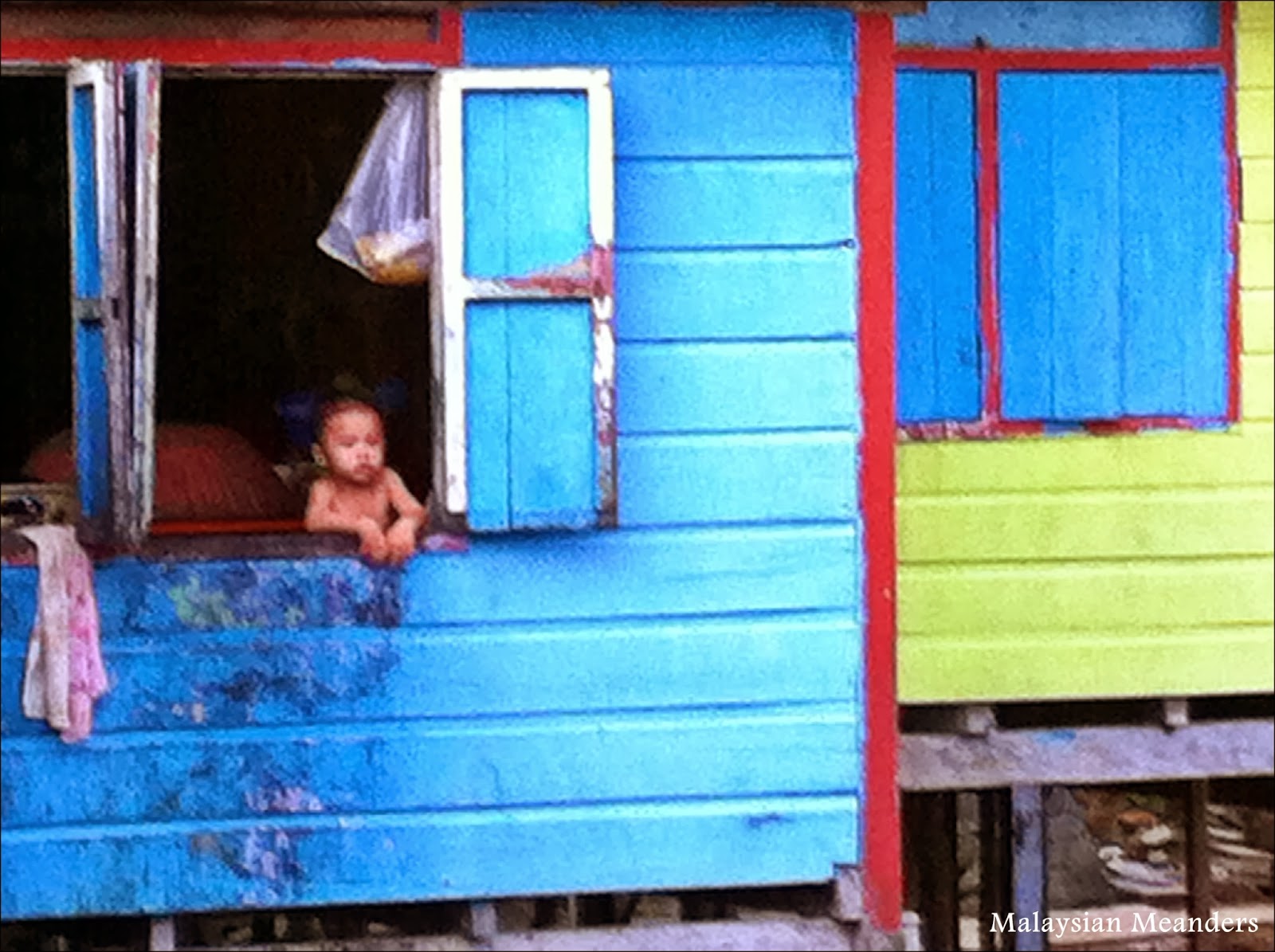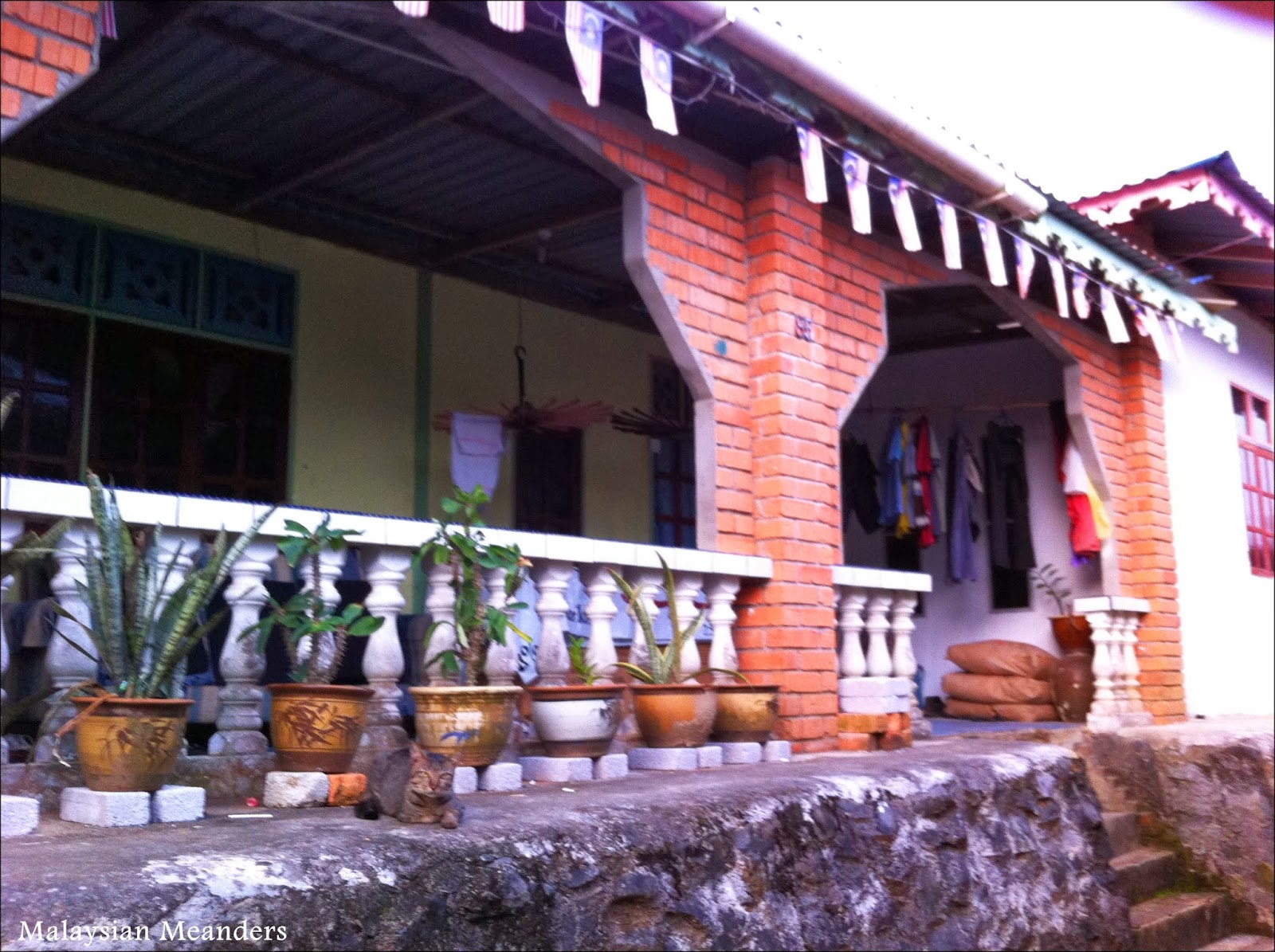Sweat is pouring off me. I raise my feet, climbing step after step, upwards on Penang Hill. At least the jungle all around me provides a natural shade canopy, shielding me from the tropical sun. Why am I doing this? Because it's there. Because my fit friends do it and seem to enjoy the trek. Because my son does it, and I feel the need to literally go over the hill to prove that I'm not
metaphorically over-the-hill. Because it's a way to experience the island while getting away from the hustle, bustle, and traffic that is George Town.
 |
| Gratuitous monkey photo |
Jungle Trek
My friend and I are taking the stairs leading upwards from the Moon Gate along Waterfall Road near the Botanical Garden. Other people ranging from athletes going on a trail run to senior citizens with trekking poles are out this morning as it's a popular hike for those looking to exercise outside. Steps are cut into the trail, keeping us from slipping on the muddy parts. Breaks in the trees give us little glimpses of the city below, showing us how far we've climbed. Monkeys look down from the branches, hoping that we'll get distracted so they can steal our water bottles. One time, a tree root suddenly starts slithering away a split moment before I realize that it's actually a long snake crossing the trail. At
Station 5, a group has apparently hiked up to play mahjong or use the exercise equipment. Tea and water are available from volunteers who have carried up the supplies.
 |
| Mahjong players at Station 5 rest area on Penang Hill jungle trek |
Hiking up the Jeep Trail
When my son and husband go with the Boy Scouts, they take the paved 5 km
Jeep Trail starting at the Botanical Garden parking lot. It's not a public road, so it's ideal for hiking. Two stations along the way provide refreshments and toilet facilities. Keep in mind your personal fitness level. My boy can make it to the top in about 90 minutes. Some other friends of mine took 4 hours to complete the same hike and couldn't walk for 2 weeks afterwards because their muscles were so sore. Other hiking trails start at Air Itam Dam, the Youth Park, and Hye Keat Estate.
Fun Time Riding the Funicular Train
By far, the most popular way to ascend Penang Hill is to take the funicular up from Air Itam. This way only takes 10 minutes and leaves you far less out-of-breath. On the other hand, it isn't free. (Tip: No matter how hard you try to speak Malay and pass yourself off as a local, they will still ask for your MyKAD card to get the discounted rate. Some expats have had success saving money by showing their visas.)
The train carries 100 people and departs every 15-30 minutes, depending on the crowd. Try to get a window with a good view of the tracks for the most excitement. There's one scary point mid-way when you swear you are about to crash into the oncoming train until they both suddenly shift to the side to avoid each other.
 |
| Newly refurbished funicular carriage |
When you reach the top, you'll be at the most developed, touristy peak called
Flagstaff Hill (Bukit Bendera) which was named after the flag that was raised there whenever the British post had arrived. At 823 meters (2,750 feet) above sea level, it has scenic vistas of George Town, the Straits of Malacca, and the mainland on a clear day. In the late 1700's when Penang was a British colony, the cooler climate up at the top encouraged the British to turn it into a hill station resort and clear land to grow strawberries. Best of all, it was free of the malaria sickness infesting the lowlands at the time.
Welcome to the Top
The main plaza near the top showcases a variety of entertainment. I've seen everything from symphonic quartet concerts to paying to have your picture taken with a giant, yellow and white, Burmese python wrapped around your shoulders. Take time to explore the rickety, wooden, funicular carriages of yesteryear that are on display. There's an Owl Museum, but frankly, everyone I know who has visited has rated it as boring, so we've never bothered to go in.
 |
| Main plaza at top of Penang Hill's Bukit Bendera |
Follow the road around to the right, and you'll come across stairs leading up to an area with a playground, Hindu temple, and mosque.
 |
| Banana tree and the only Hindu temple on Penang Hill |
The
Bellevue Hotel is a bit further along the road with an onsite
Aviary Ginger Garden that you can pay to explore. It advertises itself as the "World's First Detergent-Free Hotel." What does that mean? I don't know. Walk through the hotel to the back where the cafe has a panoramic view of the northern side of the island. Oddly, there's also a geodesic dome in honor of Buckminster Fuller who once stayed here while helping to design what is now KOMTAR.
 |
| Looking over the northern edge of the island towards Straits Quay from The Bellevue Hotel |
You Take the High Road
My favorite section at the top of Penang Hill is taking a stroll along the
Summit Road extending around to the left from the main plaza. Century-old heritage bungalows originally built for high ranking officers of the British East India Company line the road, and some of them will make you think you've stumbled upon a little cottage in jolly ole England.
 |
| Brownhead Bungalow where the well-to-do can escape to cooler air |
It's a long but easy walk. Most people hitch a ride on a buggy which are for hire at the base of the playground stairs near the main plaza for RM30-60.
 |
| Hire a buggy if you don't want to walk. |
A viewing platform by the side of the road has one of the best views from the hill. Keep an eye out for the red post box with the VR (Victoria Regina/Queen Victoria) insignia on it. It's supposedly one of the oldest in Penang and certainly on the Hill.
 |
| The oldest postbox on Penang Hill |
Carnivorous Plants
Near the end of the Summit Road, about a 30-40 minute walk, you'll find the
Monkey Cup Garden. These carnivorous pitcher plants are said to be nature's answer to how monkeys quench their thirst. I think they only resort to this when their efforts to steal tourist water bottles fail.
 |
Monkey Cups
See the spider inside the one on the bottom left? |
There's not much razzle dazzle to the garden, but my girl and I were satisfied by looking at the over 100 varieties growing here along the mossy ground trying to figure out which ones were having success at trapping insects. And silently in my head, I kept singing
the songs from Little Shop of Horrors the whole time.
 |
| A leaf frog, traditional instruments, Venus flytraps, and enjoying the swing |
Spend the Night on the Hill
One of the Boy Scouts' favorite places to camp on the island is at the
Nature Lodge of the
Methodist Centre located off Upper Tunnel Road West. Although the price is a bit too dear for single family camping, it's a great location for a group event. A sheltered area beneath the building provides protection from Penang's frequent rainstorms. There's an ample lawn for pitching tents. Best of all, a few thatched huts on stilts constructed by the
orang asli (natives) occupy the property, too. Hubby says that these stay surprisingly dry in a rainstorm, too. If you plan on camping here, you can hire a jeep from the Bellevue Hotel to carry your equipment up.
Feed Me
All that walking around makes my family a bit hungry. At the very least, the promise of ice cream has kept the kids going when they'd rather lay down on the road and refuse to move. The cheapest eats are at the
Cliff Cafe at the 3-story building at the Main Plaza. Numerous hawkers offer Assam Laksa, Char Koay Teow, Ais Kacang, and other local delights.
 |
| Cold Ais Kacang (Bean Ice) is refreshing on a hot day. |
The cafe at the back of the
Bellevue Hotel is a scenic spot to enjoy a cocktail. Watch out for pit vipers in the trees, by the way.
The fanciest restaurant is on the hillock near the upper funicular station and is called
David Brown's Restaurant and Tea Terrace. I imagine that many Penang brides must dream of having their wedding reception at such a romantic spot. While the setting was idyllic, I found the Western food to be pricey, and I didn't think that the taste measured up to the upscale meal they were aspiring to offer. Next time, I think I'll just plan on having appetizers or dessert here instead of a full meal.
 |
| Romantic David Brown's Restaurant |
Back Down Again
Your options for getting back down to the base are about the same as the ones to get up Penang Hill. Some people mix it up by running up and then taking the train down. (
Penang Momma, I'm talking about you). My boy is most in awe of a friend who longboarded down the Jeep Trail. Please make sure you have good insurance before you try this X-Games-style stunt. If you hike back down to the Moon Gate, reward yourself with a tall, cool glass of freshly squeezed juice or coconut water (nature's Gatorade) at the Juice Stand across the street.
If You Go:
- Find more information on jungle trekking trails at Forest Explorers or Penang Trails. Trails are not marked, so for the first few times, you may want to go with someone who is experienced hiking these routes. Otherwise, you can end up at the base far from where you parked the car, as my son's friends discovered.
- RapidPenang bus line 204 takes you to the bottom funicular station.
- If you are driving to the funicular station, follow the signs to "Bukit Bendera."
- Current funicular train schedules and fares can be found at the Penang Hill webpage.
- The menu and contact information for reservations at David Brown's Restaurant and Tea Terraces can be found on the webpage. Open 9AM-9PM.
- Aviary Ginger Garden at The Bellevue admission is Adults RM8 and Children RM5. Open 9AM-6PM.
- Reservations for The Methodist Centre Nature Lodge can be made at the Bellevue Hotel.

This post is part of Travel Photo Thursday on Budget Travelers Sandbox, "Oh the Places I've Been" on The Tablescaper, Sunday Traveler on Ice Cream and Permafrost, and Travel Photo Mondays on Travel Photo Discovery. Check them out for more around-the-world travel inspiration.





























































